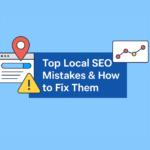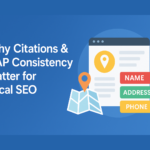- July 8, 2025
- Categories: SEO
- Tags:
Best SEO Strategy for Ecommerce Website
In the hyper-competitive world of online shopping, simply launching an ecommerce store isn’t enough,you need visibility. And that’s where SEO for ecommerce websites comes in. With millions of online stores competing for attention, a solid ecommerce SEO strategy helps you rank higher in search engines, attract the right buyers, and convert them into loyal customers.
This guide breaks down the best SEO strategy for ecommerce websites in 2025, helping you outrank competitors, reduce paid ad dependency, and maximize ROI organically.
What Is Ecommerce SEO?
Ecommerce SEO refers to the process of optimizing an online store to increase organic visibility in search engine results. It focuses on:
- Product and category pages
- Technical performance
- Content marketing
- User experience (UX)
- Mobile and Core Web Vitals compliance
Done right, ecommerce SEO can drive high-intent traffic, lower bounce rates, and improve your conversion rate without recurring ad spend.
Key SEO Ecommerce Strategies to Dominate in 2025
Let’s explore the most impactful ecommerce SEO strategies you should implement.
1. Keyword Research for Product & Category Pages
The foundation of any strong ecommerce SEO strategy begins with effective keyword research. Instead of targeting broad or generic terms, focus on buyer-intent keywords that indicate a user is ready to purchase. These can be transactional terms like “buy bluetooth headphones online”, commercial queries like “best laptops under 50000”, or long-tail phrases such as “organic hair serum for curly hair”.
Tools like Ahrefs, SEMrush, or Ubersuggest can help you identify high-volume, low-competition keywords, analyze what your competitors are ranking for, and uncover variations suitable for your product descriptions.
Pro Tip: Always assign keywords to specific landing pages. Avoid targeting the same keyword on multiple pages to prevent internal competition (also known as keyword cannibalization).
2. Optimize Product Pages for Conversions & Search
Your product pages are arguably the most important part of your ecommerce site. They must be optimized not just for search engines but also for persuading users to buy.
Start by incorporating your target keyword into the product title, meta title, and meta description. Write unique, benefit-driven product descriptions that go beyond manufacturer copy. Use high-quality images with properly written ALT tags, and implement schema markup for elements like ratings, pricing, and availability.
Also, consider adding FAQs based on common user questions,this not only boosts SEO for voice and long-tail search but also improves trust and engagement.
3. Improve Category Pages
Often overlooked, category pages are essential for SEO as they serve as mini-hubs for groups of products. Enhance them with a short introductory paragraph containing your primary keyword. Make sure the title tag and meta description are compelling and relevant.
You should also link to related categories and showcase featured products within the page to improve internal navigation. Use breadcrumb navigation to help both users and search engines understand the page’s structure and hierarchy.
Example: For a category like “Men’s Running Shoes”, optimize around keywords like “best men’s shoes for jogging” or “affordable running shoes online”.
4. Implement Technical SEO Essentials
All the keyword work in the world won’t help if your site is difficult for search engines to crawl. Start by ensuring your website is mobile-first and meets Core Web Vitals (speed, interactivity, and layout stability).
Maintain a clean, crawlable URL structure,avoid dynamic URLs like ?id=12345. Always use HTTPS for security. Implement canonical tags to prevent duplicate content issues and submit an XML sitemap to Google Search Console.
Also, avoid thin or duplicate product pages. If two pages are too similar, either combine them or use canonicalization to preserve authority.
5. Create Supporting Blog Content for Rankings
Publishing relevant blog content allows your ecommerce site to target informational search queries and drive traffic higher up in the funnel. Well-written blog posts can guide readers to your product or category pages while also building strong internal links.
Topics like “How to Choose the Right Mattress for Your Back” or “Top 10 Kitchen Appliances Every New Home Needs” not only attract traffic but build brand trust. Structure your content into clusters (pillar content + supporting blogs) to establish authority on specific themes.
6. Build High-Quality Backlinks
Backlinks are critical for building domain authority and ranking competitively. For ecommerce websites, aim to earn links from niche product review websites, collaborate with influencers, respond to journalist queries on HARO (Help A Reporter Out), and guest post on relevant industry blogs.
Launching new products or studies can also generate buzz through digital PR. Just make sure to avoid spammy directories or paid links,Google may penalize such tactics.
7. Focus on User Experience & Site Architecture
A seamless user experience (UX) not only improves conversions but also signals to Google that your website is trustworthy. Your site should load quickly, have easy-to-use filters and sorting, and a clear hierarchy from homepage → category → product.
Ensure there are prominent CTAs such as “Add to Cart” or “Buy Now,” and use smart internal linking to keep users browsing across your site. A good UX contributes directly to longer dwell times and lower bounce rates,both positive SEO signals.
8. Leverage Structured Data (Schema Markup)
Structured data (also called schema markup) helps search engines understand your content better and enables rich results in search,such as star ratings, product price, and availability. This leads to higher CTRs.
Apply schema types like:
- Product (for title, price, and availability)
- Breadcrumb (for navigation clarity)
- Review and FAQ (for added depth)
Test your schema with Google’s Rich Results Test to ensure proper implementation.
9. Use Image SEO
In ecommerce, images sell products, but they also play a role in SEO. Always use descriptive filenames like red-running-shoes.jpg, not IMG1234.jpg. Include ALT tags that describe the product while incorporating keywords naturally.
Compress your images using formats like WebP to reduce load time without sacrificing quality. Include multiple angles and lifestyle photos to enhance user engagement and relevance in image search results.
10. Monitor SEO Performance Consistently
You can’t improve what you don’t measure. Keep a close watch on key metrics like:
- Organic traffic to product and category pages
- Bounce rate and average session duration
- Conversion rate from organic users
- Keyword rankings (branded and non-branded)
- Indexed vs non-indexed pages
Use tools such as Google Search Console, GA4, Ahrefs, and Screaming Frog to monitor progress, identify issues, and iterate your strategy accordingly.
Avoid These Common Ecommerce SEO Mistakes
- Duplicate product pages with minimal content
- Auto-generated or generic meta descriptions
- Ignoring image compression
- Not targeting long-tail keywords
- No internal linking between related products or blogs
Ecommerce SEO Is an Ongoing Strategy
The best ecommerce SEO strategy combines technical strength, keyword precision, compelling content, and a stellar user experience. Unlike paid ads, SEO continues to deliver ROI over time,attracting high-intent buyers without draining your budget.
If you want to increase your rankings, reduce cart abandonment, and scale your sales organically, there’s no better time to prioritize your ecommerce SEO than now.
Need Help Optimizing Your Ecommerce Site?
At VP Advertising Agency, we help ecommerce brands build search-first strategies that drive traffic and sales. From keyword mapping to CRO-focused product optimization, we handle it all.




